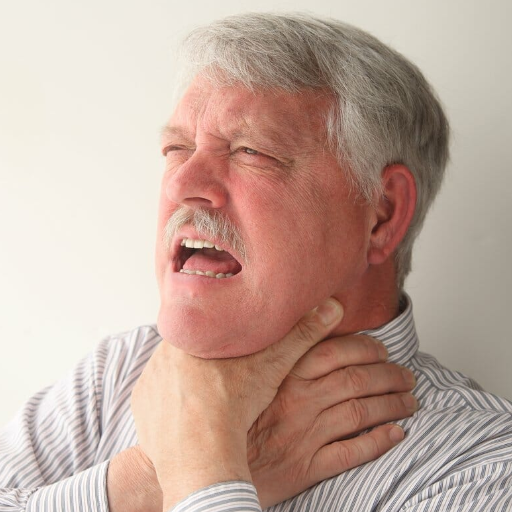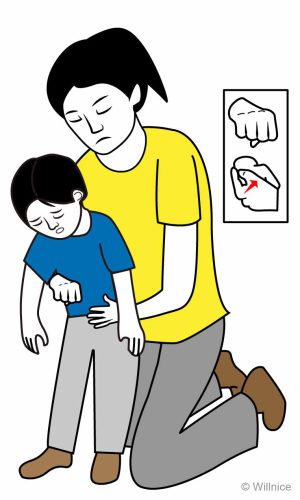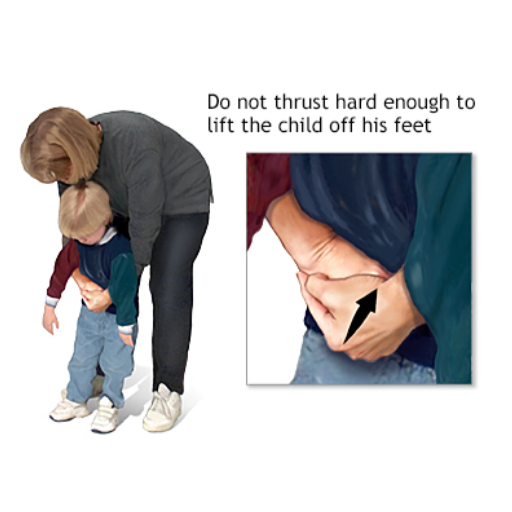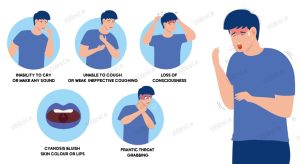
Choking is a severe medical emergency that requires quick and effective action. In this blog post, we will explore how to recognize the signs of choking, the steps to perform first aid, and the Heimlich maneuver that can help save a life. From identifying choking in adults and children to understanding why someone who is choking can't cough or speak, this article will guide you through essential first-aid techniques. We will also cover critical prevention tips, common choking hazards, and when seeking medical help is necessary. Furthermore, we'll discuss the importance of first aid training, the benefits of taking a first aid course, and resources like the American Red Cross and first aid apps that can help you be prepared for emergencies. Knowing how to act in the event of choking can make all the difference, whether at home, in the workplace, or out with friends.
 Choking happens when the airway is blocked, partially or entirely, so air cannot flow to the lungs. It is essential to seek help as soon as possible while there is still time to remedy the situation. The most favorable sign for a person with aspiration is shortness of breath, which usually leads to wheezing or gasping for air. This can lead to aspiration. A person may also have trouble making any noise or be unable to speak entirely; their face may become red or blue from lack of oxygen. Other symptoms include a person clutching his or her throat and trying to clear the mouth out. They may show distress or panic... Most commonly, this is due to some respiratory obstruction in the airway. When these signs are present, it is critical to respond promptly, as matters may go out of hand without necessary precautions.
Choking happens when the airway is blocked, partially or entirely, so air cannot flow to the lungs. It is essential to seek help as soon as possible while there is still time to remedy the situation. The most favorable sign for a person with aspiration is shortness of breath, which usually leads to wheezing or gasping for air. This can lead to aspiration. A person may also have trouble making any noise or be unable to speak entirely; their face may become red or blue from lack of oxygen. Other symptoms include a person clutching his or her throat and trying to clear the mouth out. They may show distress or panic... Most commonly, this is due to some respiratory obstruction in the airway. When these signs are present, it is critical to respond promptly, as matters may go out of hand without necessary precautions.
 In instances of choking, it is not panic. The first step is to check if the person can cough or say anything. If the person cannot speak, encourage them to cough, as it can help free the object. However, if a person cannot cough, speak, or breathe, then action is required. One of the most efficient techniques for assisting a person experiencing choking is the Heimlich maneuver, which is based on forcing air out of the lungs via abdominal thrusts to release an obstruction. If the Heimlich maneuver fails or is not an option, back blows, or chest thrusts may have to be performed. There is a need to be quick as the person can fall unconscious due to a lack of blood flow to the brain when the airway is blocked for a long. If the individual has become unconscious, then CPR may be needed until help arrives.
In instances of choking, it is not panic. The first step is to check if the person can cough or say anything. If the person cannot speak, encourage them to cough, as it can help free the object. However, if a person cannot cough, speak, or breathe, then action is required. One of the most efficient techniques for assisting a person experiencing choking is the Heimlich maneuver, which is based on forcing air out of the lungs via abdominal thrusts to release an obstruction. If the Heimlich maneuver fails or is not an option, back blows, or chest thrusts may have to be performed. There is a need to be quick as the person can fall unconscious due to a lack of blood flow to the brain when the airway is blocked for a long. If the individual has become unconscious, then CPR may be needed until help arrives.
 The first aid measures for a choking child differ from those of adults in that the child’s airways are small, and the measures may be more delicate. If the child is awake, able to cough, and is told to cough, it is best to assist with clearing the airway as it is often the most comfortable way of removing anything blocking the windpipe. If the child cannot cough, speak, or breathe, you must take action. They can perform the Heimlich maneuver only for children older than one year, still the force applied must be lesser than that which was used in adults. For infants up to one year, first aid for back blows and chest thrusts is said to be more effective. You should do five such back blows in which the heel of your hand is used between the shoulder blades of the infant. Without eye contact and response, over five chest thrusts are recommended. If the infant is rendered unconscious, commence CPR without hesitation.
The first aid measures for a choking child differ from those of adults in that the child’s airways are small, and the measures may be more delicate. If the child is awake, able to cough, and is told to cough, it is best to assist with clearing the airway as it is often the most comfortable way of removing anything blocking the windpipe. If the child cannot cough, speak, or breathe, you must take action. They can perform the Heimlich maneuver only for children older than one year, still the force applied must be lesser than that which was used in adults. For infants up to one year, first aid for back blows and chest thrusts is said to be more effective. You should do five such back blows in which the heel of your hand is used between the shoulder blades of the infant. Without eye contact and response, over five chest thrusts are recommended. If the infant is rendered unconscious, commence CPR without hesitation.
 Choking incidents can be avoided by taking preventive measures. Ensuring that children and adults understand the dangers in their surroundings is one of the most effective methods to prevent choking. Do not give young children foods with a choking hazard, like whole grapes, popcorn, or hard candy. Adults also need to be careful while taking meals and avoid situations when they may eat too fast or snatch food into their mouths instead of chewing. Likewise, the prevention of choking incidents requires that young children are kept away from small objects and other things that can be a choking hazard. Children should always be watched while eating or playing in families with toddlers because small kids tend to place things into their mouths, unaware of the dangers involved. In addition to this, it is also essential to teach other people about the risk of choking and the means that can be used to prevent it to save lives.
Choking incidents can be avoided by taking preventive measures. Ensuring that children and adults understand the dangers in their surroundings is one of the most effective methods to prevent choking. Do not give young children foods with a choking hazard, like whole grapes, popcorn, or hard candy. Adults also need to be careful while taking meals and avoid situations when they may eat too fast or snatch food into their mouths instead of chewing. Likewise, the prevention of choking incidents requires that young children are kept away from small objects and other things that can be a choking hazard. Children should always be watched while eating or playing in families with toddlers because small kids tend to place things into their mouths, unaware of the dangers involved. In addition to this, it is also essential to teach other people about the risk of choking and the means that can be used to prevent it to save lives.
 For absolutely everyone, it is essential to learn first aid for choking. Community centers, hospitals, and organizations such as the American Red Cross provide various first aid courses to those who explain the measures that should be taken in the case of strangulation or other emergencies. Most of these classes can be found in the classroom or the online mode, thus the audience has a choice based on the most desirable preference. Besides the official apps for health training, aid-issued apps can also provide calmness and effective responses to emergencies by offering the necessary procedures. Through the courses taken, people are well prepared in terms of knowledge and choice of action in the case of a choking event.
For absolutely everyone, it is essential to learn first aid for choking. Community centers, hospitals, and organizations such as the American Red Cross provide various first aid courses to those who explain the measures that should be taken in the case of strangulation or other emergencies. Most of these classes can be found in the classroom or the online mode, thus the audience has a choice based on the most desirable preference. Besides the official apps for health training, aid-issued apps can also provide calmness and effective responses to emergencies by offering the necessary procedures. Through the courses taken, people are well prepared in terms of knowledge and choice of action in the case of a choking event.
What are the Signs and Symptoms of Choking?
 Choking happens when the airway is blocked, partially or entirely, so air cannot flow to the lungs. It is essential to seek help as soon as possible while there is still time to remedy the situation. The most favorable sign for a person with aspiration is shortness of breath, which usually leads to wheezing or gasping for air. This can lead to aspiration. A person may also have trouble making any noise or be unable to speak entirely; their face may become red or blue from lack of oxygen. Other symptoms include a person clutching his or her throat and trying to clear the mouth out. They may show distress or panic... Most commonly, this is due to some respiratory obstruction in the airway. When these signs are present, it is critical to respond promptly, as matters may go out of hand without necessary precautions.
Choking happens when the airway is blocked, partially or entirely, so air cannot flow to the lungs. It is essential to seek help as soon as possible while there is still time to remedy the situation. The most favorable sign for a person with aspiration is shortness of breath, which usually leads to wheezing or gasping for air. This can lead to aspiration. A person may also have trouble making any noise or be unable to speak entirely; their face may become red or blue from lack of oxygen. Other symptoms include a person clutching his or her throat and trying to clear the mouth out. They may show distress or panic... Most commonly, this is due to some respiratory obstruction in the airway. When these signs are present, it is critical to respond promptly, as matters may go out of hand without necessary precautions.
How to Identify if a Person is Choking
Choking is one of the emergencies that, if well looked at, has very apparent signs, behaviors, and actions that include the hand clutching of the throat. This movement usually means the person is fighting to get air into their lungs. They could also be heard having a googling or wheezing sound or some form of strain, even though it appears they are trying to breathe. In the most acute forms, the person can go unconscious when the blockage in the airways becomes too severe. Changes in the skin, such as prolusion, sometimes bluish on the lips and around the face, can also be seen, meaning that the oxygen level to the cells and, more importantly, the brain is low. If these surfaces are seen, the steps must be taken to ensure that this does not become life-threatening.Understanding Symptoms of Choking in Adults and Children
The risks of choking present different warning signs when it happens to an adult and a child, while both, however, will usually demonstrate similar behaviors in distress. In most adults, what is most likely reported is an inability to breathe as well as phonation. Adults may also be able to start a bloody cough, but an entirely blocked airway will render such coughs ineffective. In this case, children do not wait for the airways to be wholly obstructed and begin to disturb the peace by crying or yelling. However, even when the choking worsens, children may be quiet and unable to scream. In either case, it is essential to understand when a person has an episode of choking with a mild degree of severity, which does permit cough, and when the degree is severe and the person cannot breathe. If a person, adult or child, is breathless or unable to talk, he must be considered a medical emergency, and first aid should be administered without delay.Why Someone Who is Choking Can't Cough or Speak
If a person is choking, the internal canal of the neck, known as the trachea, becomes obstructed. In as much as most patients relate using various food threads, the sighting of a small plastic toy penetrates the throat. As a consequence of this blockade, air cannot reach the lungs; thus, the individual is in a state of distress because the patient is having difficulty bringing the voice out. Coughing is often the body’s way of removing irritation from the airway that can indicate the presence of an obstruction, therefore, this is a normal response to the air passage which should lead to voice production. Nevertheless, on extreme occasions, there are instances where the stopper can be so big that the reflex action of coughing would be ineffective in such circumstances. It should not be a surprise either that the individual cannot produce speech as the air that passes through the vocal cords isn’t there due to a blockage of an object within the cords. To put it simply, a person who is choking is in a critical and acute situation because he/she is unable to dislodge the material that is lodged in their trachea. This explains the rationale behind using an appropriate method, for example, back blows or the Heimlich maneuver, to remove the material from the trachea as fast as possible to normalize the breathing process.
How to Help Stop Choking?
 In instances of choking, it is not panic. The first step is to check if the person can cough or say anything. If the person cannot speak, encourage them to cough, as it can help free the object. However, if a person cannot cough, speak, or breathe, then action is required. One of the most efficient techniques for assisting a person experiencing choking is the Heimlich maneuver, which is based on forcing air out of the lungs via abdominal thrusts to release an obstruction. If the Heimlich maneuver fails or is not an option, back blows, or chest thrusts may have to be performed. There is a need to be quick as the person can fall unconscious due to a lack of blood flow to the brain when the airway is blocked for a long. If the individual has become unconscious, then CPR may be needed until help arrives.
In instances of choking, it is not panic. The first step is to check if the person can cough or say anything. If the person cannot speak, encourage them to cough, as it can help free the object. However, if a person cannot cough, speak, or breathe, then action is required. One of the most efficient techniques for assisting a person experiencing choking is the Heimlich maneuver, which is based on forcing air out of the lungs via abdominal thrusts to release an obstruction. If the Heimlich maneuver fails or is not an option, back blows, or chest thrusts may have to be performed. There is a need to be quick as the person can fall unconscious due to a lack of blood flow to the brain when the airway is blocked for a long. If the individual has become unconscious, then CPR may be needed until help arrives.
Steps for First Aid for a Choking Person
Choking first aid involves specific steps to relieve the obstruction and restore normal respiration. If the victim can respond, direct them to try coughing. If they cannot, the next move is the Heimlich maneuver. To begin with, I will position myself behind the victim and encircle your waist with my arms. Make a fist with one hand and situate it above the victim’s waist. On the other hand, cover the fist and make five inward and upward movements. Repeat until the object is removed, or the victim can breathe without assistance. If the patient loses consciousness, I have to bring him to the floor and try to sequence stimulating CPR. First, start with the standard strategy of performing chest thrusts, then rescue breathes, and keep doing this until help is provided. Remember to remain calm, as panic can cloud my judgment and ability to function.How to Perform the Heimlich Maneuver Correctly
Besides being referred to as abdominal thrusts, the Heimlich maneuver can also be described as the emergency management technique for removing airway obstruction. To commence the method with proficiency, the first step would be to position yourself behind the individual experiencing choking. To do this, ensure that your feet are aligned to the shoulder height and encircle the waist of the person. The tip of the thumb presses directly above the belly button of the choking person. Then, clasp your fist with your other hand and quickly and forcefully pull your body upward. It aims to provide sufficient pressure to the diaphragm to force air out of the lungs to allow for the displacement of the airway obstruction. This procedure must be repeated many times before the client expels the object. If the patient loses consciousness, that is when you should stop the Heimlich maneuver and move on to CPR.When to Use CPR if the Person Becomes Unconscious
In cases where the choking victim is entirely limp, the rescue technique will now be CPR instead of the Heimlich colony. An individual's consciousness loss occurs when a blockage has resulted in inadequate oxygen supply to the brain, causing them to fall. At this stage, it will be futile to continue with Heimlich; prompt CPR will be required. The first step is chest compressions; kneel beside the person, place your hands on the lower half of their breasts, and thrust downward hard and rapidly, allowing the chest to bounce back to its highest point between thrusts. Following 30 thrusts, give two rescue breaths by tilting the patient’s head backward and covering their mouth with yours as you force oxygen into their lungs. Repeat the sequence of 30 thrusts and two breaths until the trapped object is dislodged or until help arrives. Cardiopulmonary resuscitation, also called CPR, is a critical restoration procedure that assists in blood circulation and oxygen intake into the essential organs of the immobilized individual until a physician is reached.
What is the First Aid for Choking in Children?
 The first aid measures for a choking child differ from those of adults in that the child’s airways are small, and the measures may be more delicate. If the child is awake, able to cough, and is told to cough, it is best to assist with clearing the airway as it is often the most comfortable way of removing anything blocking the windpipe. If the child cannot cough, speak, or breathe, you must take action. They can perform the Heimlich maneuver only for children older than one year, still the force applied must be lesser than that which was used in adults. For infants up to one year, first aid for back blows and chest thrusts is said to be more effective. You should do five such back blows in which the heel of your hand is used between the shoulder blades of the infant. Without eye contact and response, over five chest thrusts are recommended. If the infant is rendered unconscious, commence CPR without hesitation.
The first aid measures for a choking child differ from those of adults in that the child’s airways are small, and the measures may be more delicate. If the child is awake, able to cough, and is told to cough, it is best to assist with clearing the airway as it is often the most comfortable way of removing anything blocking the windpipe. If the child cannot cough, speak, or breathe, you must take action. They can perform the Heimlich maneuver only for children older than one year, still the force applied must be lesser than that which was used in adults. For infants up to one year, first aid for back blows and chest thrusts is said to be more effective. You should do five such back blows in which the heel of your hand is used between the shoulder blades of the infant. Without eye contact and response, over five chest thrusts are recommended. If the infant is rendered unconscious, commence CPR without hesitation.
How to Stop a Child from Choking with Back Blows and Abdominal Thrusts
Back blows and chest thrusts remain the most effective procedure for a child under one year of age to help relieve an obstructed airway. As for back blows, hold the child face down across one of your forearms and, with the other hand, have the child’s head and neck while supporting them. Your free hand’s palm’s heel is used to apply five deliberate blows to the child’s back between the shoulder blades. If this displacement does not remove the obstruction, roll the child and apply five chest thrusts with two fingers to the middle of the child’s chest. So, the thrusts should be rapid and forceful; they should push down about one-third of the chest depth. This sequence is repeated unless the child or the child expels the object and resumes proper ventilation. An infant should never be given the Heimlich maneuver because their chest and trachea are too delicate and require different approaches to intervention.Recognizing Choking Symptoms in a Choking Child
Choking can be harder to detect in children, especially in infants, as they might not be able to make loud choking sounds that are commonly heard in adults. Respiratory distress, wheezing, or facial grimacing are some of the other signs of choking in a child. Younger children may cry, but once their airway is compromised, they can go silent waves even though they are not distressed. Infants, on the other hand, can choke and not be able to make a sound due to their faces turning red or blue. If the child cannot cry, cough, or take a proper breath, they are in serious trouble and must be treated immediately. These measures prevent a routine choking event from turning into a tragedy.When to Seek Medical Help in an Emergency
After an object has been removed from a person’s throat or if a person is in an unconscious state, all medical help should be summoned without delay. Even in cases where the obstruction has been removed, a medical examination should still be performed as the person may have sustained some form of airway injury or bleeding from within the body, which is not easily visible. Once in this state, if a person cannot become fully alert after that or continues struggling or can breathe after the object has been removed, 911 or whichever local emergency services would be essential to contact. Also, when a child has been in situations of choking, a trip to the emergency room is recommended regardless of the child’s condition after the incident.
How Can You Prevent Choking?
 Choking incidents can be avoided by taking preventive measures. Ensuring that children and adults understand the dangers in their surroundings is one of the most effective methods to prevent choking. Do not give young children foods with a choking hazard, like whole grapes, popcorn, or hard candy. Adults also need to be careful while taking meals and avoid situations when they may eat too fast or snatch food into their mouths instead of chewing. Likewise, the prevention of choking incidents requires that young children are kept away from small objects and other things that can be a choking hazard. Children should always be watched while eating or playing in families with toddlers because small kids tend to place things into their mouths, unaware of the dangers involved. In addition to this, it is also essential to teach other people about the risk of choking and the means that can be used to prevent it to save lives.
Choking incidents can be avoided by taking preventive measures. Ensuring that children and adults understand the dangers in their surroundings is one of the most effective methods to prevent choking. Do not give young children foods with a choking hazard, like whole grapes, popcorn, or hard candy. Adults also need to be careful while taking meals and avoid situations when they may eat too fast or snatch food into their mouths instead of chewing. Likewise, the prevention of choking incidents requires that young children are kept away from small objects and other things that can be a choking hazard. Children should always be watched while eating or playing in families with toddlers because small kids tend to place things into their mouths, unaware of the dangers involved. In addition to this, it is also essential to teach other people about the risk of choking and the means that can be used to prevent it to save lives.
Common Choking Hazards and How to Avoid Them
Everyday circumstances always present the possibility of choking on something; some are far more common than others. Very young children, especially infants and toddlers, are at risk of choking on small toys and even buttons and coins. In adults, this is more or less related to food, especially when consuming large chunks of difficult-to-chew meat and sticky food like peanut butter or alcohol, suppressing the swallowing reflex. These sources of risk need to be understood, and measures must be taken to prevent them from happening. If children are being fed, it is prudent always to cut the food into smaller pieces and sit them upright. Equally important, when making preparations for meals, ovate individuals who may have a difficult time swallowing or have a condition that makes it easy for them to choke. Reduce the likelihood of being accidentally choked while eating by abstaining from talking, laughing, or running around.Tips to Prevent Choking in Adults and Children
Both adults and parents can take several measures to reduce the risk of choking. Children should be supervised anytime they are eating meals or having snacks. Do not give kids large pieces of food or food likely to be lodged in the throat if swallowed. Adults, in particular, need to be completely careful not to swallow their food before it has been thoroughly chewed and laugh or speak when food is in the mouth. Do not have attention-seekers such as a TV or phone during your meals. Parents with young children should ensure that small items that can be swallowed or choked are regularly cleaned around the house. An adult family member of the household should educate all family members, particularly children, on the hazards of choking and the importance of being observant to avoid such unfortunate incidents.What Risk Factors for Choking Should You Be Aware Of?
Young children, especially those under five years, are often at risk because they are at the stage of putting everything in their mouths as a means of understanding their environment. Elderly adults with atrophied swallowing muscles or neurological deficits associated with dementia, Parkinson's Disease, or any other condition that affects the swallowing reflex or ability should also bear in mind that they may have a higher risk. Relatives of patients with dentures or impaired swallowing should take more caution, as these factors contribute to their inability to chew or properly swallow the foods. Knowing the risk factors involved will also allow you to implement extra measures to guard those most at risk of choking.
Where Can You Learn First Aid for Choking?
 For absolutely everyone, it is essential to learn first aid for choking. Community centers, hospitals, and organizations such as the American Red Cross provide various first aid courses to those who explain the measures that should be taken in the case of strangulation or other emergencies. Most of these classes can be found in the classroom or the online mode, thus the audience has a choice based on the most desirable preference. Besides the official apps for health training, aid-issued apps can also provide calmness and effective responses to emergencies by offering the necessary procedures. Through the courses taken, people are well prepared in terms of knowledge and choice of action in the case of a choking event.
For absolutely everyone, it is essential to learn first aid for choking. Community centers, hospitals, and organizations such as the American Red Cross provide various first aid courses to those who explain the measures that should be taken in the case of strangulation or other emergencies. Most of these classes can be found in the classroom or the online mode, thus the audience has a choice based on the most desirable preference. Besides the official apps for health training, aid-issued apps can also provide calmness and effective responses to emergencies by offering the necessary procedures. Through the courses taken, people are well prepared in terms of knowledge and choice of action in the case of a choking event.
Benefits of Taking a First Aid Course
Learning first aid can effectively counter choking or any other medical emergency. It also teaches the individual to be calm and composed even in highly challenging situations. In such programs, participants are taught how to perform CPR, how to use the Heimlich maneuver, and other relevant first-aid procedures concerning choking in both adults as well as children. Simulation of real situations is also a part of the curriculum, where students practice the techniques of manikins. Practicing first aid is not only for your benefit but also for other people, so it is a worthwhile investment. And one day, it may be in high demand.How the American Red Cross Can Help You Prepare
One of the top organizations that offers First Aid and CPR training is the American Red Cross. Their courses focus on different types of emergencies, choking, and handling such situations quickly. The Red Cross has on-site and online options, so you can pick the one that suits you best. After finishing these valuable courses, one acquires a certificate beneficial to caregivers, teachers, coaches, and other authorities. The Red Cross offers useful tools like an emergency preparedness kit and a first aid app to assist in readiness for different situations. Taking a course from the American Red Cross can guarantee anyone that the training received was of the highest standard and quality.Using a First Aid App for Quick Guidance
In the current information era, where clicking a button can resolve an issue, first aid apps can help people deal with many emergency problems, such as choking. Advanced technology also allows apps to feature audio and video guidance on performing significant maneuvers and methods such as the Heimlich maneuver or CPR. First aid apps can be installed on a mobile device and utilized anytime, making them a critical asset in a choking scenario. Although many of these free applications give the user an upper hand when needed. Using these essential first aid applications will assure an individual that they can face any emergency because these applications are in real-time; hence, swift help can be rendered.
References
Choking First aid Abdominal thrustsFrequently Asked Questions (FAQ)
Q: What should I do if someone is choking?
A: If someone is choking and cannot breathe or speak, perform five back blows between the person's shoulder blades using the heel of your hand. If the blockage does not clear, proceed with five abdominal thrusts, also known as the Heimlich maneuver, to dislodge the foreign object.Q: How can I help someone who is choking if they are conscious?
A: To help a conscious person who is choking, stand behind them and use back blows and abdominal thrusts. First, give five back blows between the shoulder blades with the heel of your hand, then give up to five abdominal thrusts by making a fist with your other hand and positioning it above the abdomen.Q: What steps should be taken if the choking person becomes unconscious?
A: Call emergency services and begin cardiopulmonary resuscitation (CPR) if the person is unconscious. If trained, begin chest compressions and rescue breaths and continue until help arrives or the person regains consciousness.Q: How do you perform the Heimlich maneuver on a child or baby?
A: For a child, use the same method as for an adult, but be gentler with your force. For a baby, lay the child face down on your forearm, supporting the head, and give five gentle back blows. Then, turn the baby over and give five chest thrusts using two fingers on the center of the chest.Q: What should I do if I am alone and choking?
A: If you are alone and choking, call emergency services first. Then, try to perform abdominal thrusts on yourself by placing a fist above your abdomen and thrusting inward and upward. Alternatively, lean over a firm object like the back of a chair to give yourself abdominal thrusts.Q: Why is it important to keep the head lower than the chest when performing back blows on a choking infant?
A: Keeping the head lower than the chest helps gravity dislodge the foreign object from the infant's airway.Q: What are the signs that someone is choking and needs immediate assistance?
A: Signs that someone is choking include inability to breathe or cough, turning blue, inability to speak, and clutching their throat. Immediate assistance is required to clear the airway.Q: Can small objects cause choking, and how can this be prevented?
A: Yes, small objects may cause choking, especially in children. To prevent choking, keep small objects and pieces of food out of reach of children and supervise them during meals.Q: What should I do if the standard method doesn’t clear the airway?
A: If the standard method doesn’t work, alternate between five back blows and five abdominal thrusts until the object is dislodged or emergency services arrive.Q: How can I improve my first aid skills for choking emergencies?
A: To improve first aid skills, consider taking a certified first aid course that covers choking first aid, including the Heimlich maneuver and CPR techniques. Regular practice and refreshers can help maintain these skills.1653








 Login with Google
Login with Google Login with Facebook
Login with Facebook